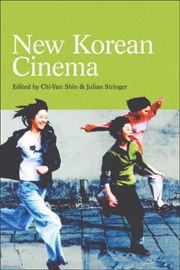Book contents
- Frontmatter
- Contents
- Notes on the Contributors
- List of Illustrations
- Introduction
- Part I Forging a New Cinema
- 1 Contemporary Cultural Production in South Korea: Vanishing Meta-Narratives of Nation
- 2 The Korean Film Industry: 1992 to the Present
- 3 Globalisation and New Korean Cinema
- 4 Chunhyang: Marketing an Old Tradition in New Korean Cinema
- 5 ‘Cine-Mania’ or Cinephilia: Film Festivals and the Identity Question
- Part II Generic Transformations
- Part III Social Change and Civil Society
- Glossary of Key Terms
- Bibliography of Works on Korean Cinema
- Websites
- Index
4 - Chunhyang: Marketing an Old Tradition in New Korean Cinema
from Part I - Forging a New Cinema
Published online by Cambridge University Press: 05 August 2013
- Frontmatter
- Contents
- Notes on the Contributors
- List of Illustrations
- Introduction
- Part I Forging a New Cinema
- 1 Contemporary Cultural Production in South Korea: Vanishing Meta-Narratives of Nation
- 2 The Korean Film Industry: 1992 to the Present
- 3 Globalisation and New Korean Cinema
- 4 Chunhyang: Marketing an Old Tradition in New Korean Cinema
- 5 ‘Cine-Mania’ or Cinephilia: Film Festivals and the Identity Question
- Part II Generic Transformations
- Part III Social Change and Civil Society
- Glossary of Key Terms
- Bibliography of Works on Korean Cinema
- Websites
- Index
Summary
The story of a beautiful woman who challenges the social prejudice of her lower-class origin and marries above her social position is a universal source material of romantic tales in many cultures. The Tale of Chunhyang is the Korean archetype of this notion of feminine beauty. Chunhyang appeared in a shamanistic legend in early eighteenth-century Korea. Henceforth, her story appeared in many oral-narrative folk traditions. Through time, her beauty has been variously recreated and refined according to the specific demands and concerns of successive audiences. Furthermore, her story has been remade in almost every medium for popular entertainment in each period, such as P'ansori (Korean traditional operatic drama), Chinese poems, popular novels, stage dramas, Western-style operas, films and television dramas. The various aesthetic orientations of each medium can be seen in the relationship between text and audience as revealed through the various transformations (Chǒn 1998). The essence of the folk-tale embodies the popular desire of a Utopian society. Her courageous rebellion triumphs over the prevailing class system. The inevitability of the narrative's internal motif and appropriateness of external elements, however, determine the extent of acceptance or rejection by the audience. Therefore, the dramatic variations between the versions clearly reflect the deciding role of the audience as the subjects of the oral tradition through its historical transmission (Chǒn 2003). The significance of the tale in Korean film history can be seen in its many versions.
- Type
- Chapter
- Information
- New Korean Cinema , pp. 63 - 78Publisher: Edinburgh University PressPrint publication year: 2005

